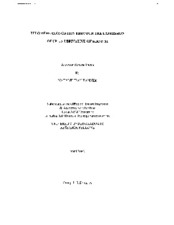| dc.description.abstract | As little as a decade ago, the cloning of an eukaryotic organism was generally thought of as an element in a science fiction novel, however, today the procedure is a reality. Genetic modification of cloned animals is also becoming a feasible idea, one that has the potential to create extensive benefits in the areas of medicine and agriculture. Transgenic animals would make it possible to develop livestock that produce high amounts of lean meat or high volumes of milk without the use of hormones. Transgenic animals would make it possible to develop livestock that produce high amounts of lean meat or high volumes of milk without the use of hormones. Transgenic pigs have the potential to save hundreds of thousands of peoples' lives by providing organs for xenotransplantation; the transplant of an organ across species. There are many barriers leading to the production of transgenic animals, one being that the genetic modifications must be done in vitro. Often, before the necessary modifications are complete, the cultured somatic cells will have reached senescence, a genetically determined event defined as cell aging and eventually death. The specific cause of senescence has not been determined, but several contributing factors have been identified. The telomere, located at the end of the chromosome, has been proven to play a role in senescence, although it is not clear as to whether its structure or length is the larger determinant. It has been concluded that each time the cell divides, the telomere length shortens, eventually leading to the instability of the chromosome and senescence of the cell. Because telomere length continually decreases, somatic cells can undergo only a limited number of divisions before reaching senescence. My research is examining telomere lengthening in order to extend the cellular life span through the expression of dominant-negative domain of the naturally occurring heterogeneous nuclear ribonucleoprotein A1 (hnRNP-A1), a gene that has been linked to the telomere mechanism. A dominant-negative is a protein that has been modified to express some characteristics of that protein while repressing others. In this case, the dominant-negative domain UP1 has the unique property of encasing the telomere while its mRNA splicing characteristics have been turned off. Theoretically this protective coat will encase the telomere and protect it from degradation during cell division, therefore delaying senescence of the cell. Once the dominant-negative UP1 gene was isolated and introduced into porcine fetal fibroblast cells, colonies producing high UP1 expression were selected and expanded. These colonies were then subject to several tests in order to determine the effects of the modified protein. The technique of Population Doubling Factor (PDF) was used to determine if the somatic cells have increased in their number of divisions compared to a control set of cells. Upon completion of PDF analysis, tests for telomerase activity, an enzyme proven to lengthen telomere length in stem cells, were conducted to rule out this confounding variable. Our results from the PDF trials did indicate cellular life extension in the somatic cells expressing UP1. Further tests examining telomere length and cellular karyotype must be explored before any definitive conclusions can be drawn, however, the PDF experiment yielded encouraging results as to the prospect of somatic cellular life extension in vitro. | en |


